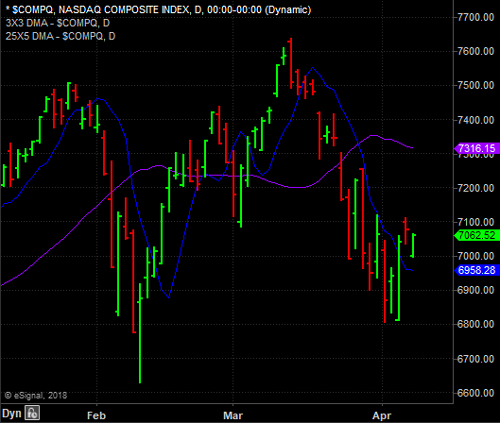Trade Wars and Macro Market Analysis
Published on April 6, 2018 @ 12:12pm
Since trade seems to be the big topic of conversation these days, I thought we'd provide a few thoughts and a few facts on the subject today before we get into what we're seeing with the major indices today.
The U.S. says higher tariffs, we just want a fair playing field. China says nope, we're going to raise our tariffs even more. It reminds me of a spoiled kid that threatens to thrash the household if he doesn't get his way. However, China has also been the biggest purchaser of U.S. Treasuries in recent years, which has actually helped keep interest rates historically low, so we're tied at the hip in many more ways than most Americans think.
In 2017, the U.S. trade deficit with China was $375B. The trade deficit exists because U.S. exports to China were only $130B, while imports from China were $506B. Although the United States imports everything from consumer electronics to clothing and machinery from China, a lot of those imports are from U.S. manufacturers that send raw materials back to China for low-cost assembly. Once shipped back to the United States, they are considered imports.
The reason China is able to produce goods at a much lower cost is quite simple - their massive population is used to an abnormally low standard of living. Therefore, since American's refuse to accept the China standard of living, yet want goods as inexpensive as possible, they're willing to buy China made goods. The problem is those China goods have continued to cost Americans jobs. So we buy their goods on the cheap, and then complain about not enough jobs.
So what if China calls in the massive amount of U.S. debt they've purchased? Interest rates would likely sky rocket, which would then trigger a U.S. and global recession, and the China economy would likely be the biggest sufferer. Why? Because although the U.S. is the largest consumer of imports in the world, China is the largest exporter in the world. And, if those exports come to a screeching halt, China's rapid growth over the last few decades, which is already on shaky ground, would likely come to a screeching halt as well.
Basically, there's way too much for both sides to lose. However, when you consider the poor standard of living in China for most of their population, and you consider the underlying political unrest over there, I think China has far more to lose if this trade issue continues to escalate.
We might simply end up having to pay more for goods, but we'll actually create more jobs, while many families in China would dive further into poverty. I'll take the former.
The markets have reversed to the downside once again this morning, however, it's nothing to be too overly concerned about yet. The markets had a big reversal to the upside on Wednesday, but stalled yesterday. The price action yesterday was clearly a lack of conviction on both sides of the trade again.
Then, the markets gapped lower this morning, which was merely an attempt to see if they can attract buyers like they did on Wednesday. So far this morning, it seems to be working. Provided here is a daily chart of the NASDAQ Composite, which clearly depicts above.
The bigger issue though is the recent trend pattern. As you can see, ever since the NASDAQ topped out earlier last month, up until the last few days the index had continued to stay below its 3X3 DMA (displaced moving average blue line). The index is clearly in a downtrend on a short-term basis right now.
More importantly, even though the index has found its way back above its 3X3 DMA over the last few days, when a stock or financial instrument has been below its 3X3 DMA for as long as the NASDAQ has been recently, it often breaks down again within three or four days of being above its 3X3 DMA. Meaning, despite the markets' recent strength over the last few days, all of the major indices still actually have the technical right to find their way back below their 3X3 DMA's at any point over the next few trading days.

Therein lies the lack of conviction on both sides of the trade right now, because from both a fundamental and technical perspective, there's an argument for a developing bottom right now, as well as the possibility of one more big swoon to the downside.
